#ernst burke
Text
Ernst Burke

A/N: You thought I was done with the Burke Family 😏😏🤣🤣. Well Ladies and Gentlefolk, you are to be proved wrong! because guess what?! This family is big and I mean BIG! They have one huge web of a family tree. But that is to be discussed in another post later. Today we discuss the oldest Burke brother and sibling, Ernst Burke.
Name: Ernst Adeodatus Richard Burke
Born: 15th August 1879
Nicknames: none so far.
Name Meaning: Serious or Battle unto death (I'd say 78% of his personality)
Gender: Male
Gender Identity: Wizard (he/him)
Sexuality: heterosexual
Zodiac Sign: Leo
Blood Status: Pureblood.
Nationality/Ethnicity: White British.
Physical Appearance.

Face Claim: Daniel Sharman
Hair: Chocolate brown
Eye Colour: Chocolate Brown
Height: 5 feet, 11 inches (1.8034m)
Weight: 69kgs
Skin Colour: Pale Ivory
Style: The usual upper-class wear of the late 19th century and early 20th century. Has at least one million ties for every occasion cus he loves them 🤣
Personality: Myers -Briggs Type: ENFJ-A, (the protagonist)
Strengths: Reliable, Receptive, Altruistic and Charming.
Interest/Hobbies: Ancient Art, playing the violin, Stamp collecting.
Weaknesses: Overly empathetic, Intense, condescending.
Distinguished marks:
a scar on his elbow from when he fell while playing football for the first time.
History:
Ernst was born, Ernst Adeodatus Richard Burke to an ancient and powerful pureblood family, the house of Burke. Being the First-born son, his birth was celebrated with great delight by both of his parents. His father had high hopes for him, to become a man exactly like him; a man of power. For most of his young life, Ernst tried his uttermost to live up to his father's expectations, meeting the people he wanted him to, and making relations with those his father wanted to.
But then he had an epiphany. Gradually a slight rebellious streak peeked through in his personality, understanding that his father was in the wrong. As a man, he soon became a natural leader, a man always ready for debate yet reserved and observant.
At a young age, his parents disowned his younger brother unbeknownst to Ernst who grew up without the knowledge of his younger brother. He was a protective and loving brother who scolded his siblings when they were in the wrong yet was always up for a game of charades with them. In his third year, he met with his estranged brother, Albert and they both immediately formed a lifelong strong bond.
At the age of 25, he married a close friend and the love of his life Loise Greengrass. And his story continues thus.
Witchcraft:
1st Wand: Black Walnut wood, 11 inches, unicorn hair core, brittle flexibility.
Less common than the standard walnut wand, that of black walnut seeks a master of good instincts and powerful insight. Black walnut is a very handsome wood, but not the easiest to master. It has one pronounced quirk, which is that it is abnormally attuned to inner conflict, and loses power dramatically if its possessor practises any form of self-deception. If the witch or wizard is unable or unwilling, to be honest with themselves or others, the wand often fails to perform adequately and must be matched with a new owner if it is to regain its former prowess. Paired with a sincere, self-aware owner, however, it becomes one of the most loyal and impressive wands of all, with a particular flair in all kinds of charmwork.
Unicorn hair generally produces the most consistent magic and is least subject to fluctuations and blockages. Wands with unicorn cores are generally the most difficult to turn to the Dark Arts. They are the most faithful of all wands, and usually remain strongly attached to their first owner, irrespective of whether he or she was an accomplished witch or wizard.
Animagus Form: None
Patronus: A Barn owl
Patronus memory: His first quidditch at Hogwarts match to which all his family had come and cheered for him.
Later Patronus memory: His newly formed family including all of his siblings and their families spending Christmas together.
Boggart: to be determined
Riddikulus: To be determined.
Amortentia (what does he smell like?): whiskey, fresh grass, a warm fire, cinnamon, ironed shirt
Amortentia (what does he smell?): honey, gardenias, Scottish valley, fresh river water, musty silk
Magical Abilities: none so far
At Hogwarts
Hogwarts house: Slytherin
Best Subjects: Defence against Dark Arts, Potions, Charms, Flying
Worst Subjects: Transfiguration, History of Magic
Elective Subjects: Care of Magical Creatures, Ancient Runes, Arithmancy, advanced Arithmancy and Alchemy (someone tell his father he needs a break!)
N.E.W.T.S: Defence against the Dark arts, Ancient Runes, Care of Magical Creatures, Potions and Alchemy.
Extracurricular activities: Flying, Muggle music, Art and Ancient studies.
Career
11-18: Hogwarts students
18-23: Worked as a ministry official in the department of magical law enforcement.
24-31: Active auror at the Ministry
31-death: Marquess Burke.
Relationships
Family:
Albert Burke:
When Albert came into the world, Ernst saw it as a great responsibility of his to take care of his adorable little brother. All his young days were spent playing and having the best of his days with Albert. But suddenly, Albert was gone, confusing Ernst, who was four at the time. But his parents told him that Albert was a distant cousin who left after his parents came back to get him. Ernst had no choice but to believe them. But, eventually, on one fateful day in his fourth year when he met a young boy whom he found out to be his long-lost brother. The boys although very different in personalities, Ernst being a natural leader and Albert being a shy youngster, soon grew an unbreakable and close bond well till their old age.
Alexander Burke:
The mischievous yet hooly jolly little brother. Ernst and Alexander were almost polar opposites the latter being rambunctious while the prior being rather sober. And truth be told Ernst did go to great lengths to get his younger brother out of all of his mischief in all of his younger days, but they still love each other (even though Ernst still hasn't forgiven him for stealing his favourite book and using the pages to make paper boats).
Cordelia Burke:
While Ernst adored his younger sister, Cordelia grew up always striving to be like her oldest brother. Although as they grew older their relationship was strained due to Cordelia's harsh comments about their brother Albert and sister Octavia. But eventually, Ernst accepted her apology and worked towards fixing their relationship.
Octavia Burke:
The first time when Ernst heard about Octavia joining the forces of you-know-who, he felt the most betrayed. He adored his little sister, who never failed to charm him. They spent many days during Ernst's time before Hogwarts walking under the stars and having the time of their lives. But the relationship came to an abrupt end after her downfall to evil.
Aurelian And Gwydion Burke:
As the first-born son of the family, Ernst's parents had HUGE expectations for him. For most of his life, Ernst spent trying to impress his father and mother. Finally, he saw the light, understanding he did not have to live his life trying to live up to his father's impossible standards but more trying to be himself. He finally came out of their shadow and found his true self. His mother had a slightly better relationship with him and he was the last one she spoke to before her passing.
Love Interest:
Lady Louise Florence Greengrass (profile coming soon): The sweet and gracious lady Louise charmed the heart of many men in her days, but the one who charmed her heart was Ernst Burke. The two fell head over heels for each other but had to wait until Louise was 20. Finally, they both Married two years after Ernst graduated, and they both built a happy family. Louise was a calm-minded person, who always helped Ernst let out his frustrations, while Ernst was always there to accompany her adventures into the forests and hillsides of Scotland. She was a liberal, brave and strong-hearted woman who never ceased to amaze Ernst.
Friends: Requests are open for his friendships!
Enemies: Requests are open for this too.
#hogwarts legacy#hphl#hphl profile#hphl mc#ernst burke#harry potter#wizarding world#hogwarts legacy mc
26 notes
·
View notes
Text
You can now reblog! Free scifi stories from 1932!!
you can ignore the numbers those are for my compilation
January 1932
120 Creatures of Vibration by Harl Vincent
121 The Mind Master by Arthur Josephus Burks
122 The Winged Men of Orcon by David R Sparks
123 The Seed of the Toc-Toc Birds by George Henry Weiss
x Giants on the Earth by Sterner St. Paul Meek
124 The Radiant Shell by Paul Ernst
February 1932
125 The Pygmy Planet by Jack Williamson
126 Wandl, The Invader by Ray Cummings
127 Seed of the Arctic Ice by Desmond W Hall
128 The Space Rover by Edwin K Sloat
x The Mind Master by Arthur Josephus Burks
129 Zehru of Xollar by Hal K Wells
March 1932
130 Poisoned Air by Sterner St. Paul Meek
131 The Affair of the Brains by Anthony Gilmore
132 The Hammer of Thor by Charles Willard Diffin
133 Vampires of Space by Sewell Peaslee Wright
April 1932
134 B.C 30,000 by Sterner St. Paul Meek
135 The Finding of Haldgren by Charles Willard Diffin
136 The Einstein See-Saw by Miles John Breuer
137 The Great Dome on Mercury by Arthur Leo Zagat
May 1932
138 Pirates of the Gorm by Nat Schachner
139 The Martian Cabal by Roman Frederick Starzl
140 The Great Drought by Sterner St. Paul Meek
141 The Bluff of the Hawk by Desmond W Hall
June 1932
142 Vulcan's Workshop by Harl Vincent
143 Two Thousand Miles Below by Charles Willard Diffin
144 Hellhounds of the Cosmos by Clifford D. Simak
145 The Raid on the Termites by Paul Ernst
146 Priestess of the Flame by Sewell Peaslee Wright
July is missing
August is missing
September 1932
147 Loot of the Void by Edwin K. Sloat
148 Disowned by Victor A Endersby
149 Raiders of the Universe by Donald Albert Wandrei
150 Slaves of Mercury by Nat Schachner
October is missing
November 1932
151 The Cavern of the Shining Ones by Hal K Wells
152 A Scientist Rises by Desmond Winter Hall
153 When the Sleepers Woke by Arthur Leo Zagat
154 The Passing of Ku Sui by Desmond Winter Hall
December is missing
#Rjalker compiles Astounding Stories of Super-Science#Astounding Stories of Super Science#Astounding Stories of Super-Science 1932#free books#scifi#science fiction#vintage fiction#vintage scifi
9 notes
·
View notes
Text
HPHL AU: Victoria Somerset successfully carries all of her pregnancies and Primrose grows up with five more siblings

Augusta Victoria Gray, b. 1879
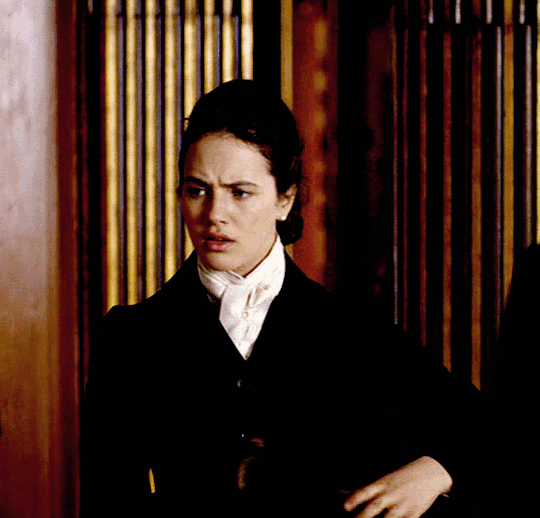
Firstborn daughter of Victoria Somerset and Vincent Gray, she was for many years the heir to the viscountcy of Winbourne. Betrothed at the age of two with her cousin, George Barton, grandson of Olympia Barton. The two of them worked a successful marriage despite its rocky beginning
Primrose Sabrina Gray, b. 1881
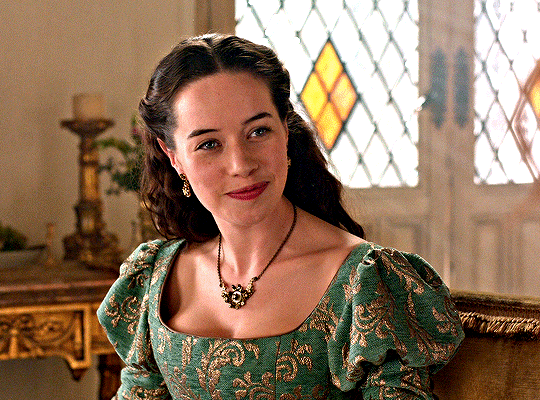
The second daughter and with more liberty to marry, she never inherited the viscountcy and became the Countess of Harrendale via her marriage to Malcolm Stolberg-Burke. She lived a happy life, far away from court intrigues @gaygryffindorgal
William Benedict Gray, b. 1882
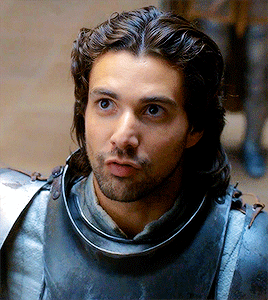
Third child and Lord of Winbourne from the moment he was born, he married a beautiful and witty daughter of a marquis and was the viscount until his late sixties. He left behind a wife, eight children and a vast family.
Ernst Augustus Gray, b. 1884

Second son, he was a libertine and highly scandalous, always in houses of ill repute and soon contracted several venereal diseases at the age of 21. He never married and passed away, alone and bitter at age 46
Mary Alexandra Gray, b. 1886

A wild, precocious child, she didn't marry well until into her 30s, for she preferred to travel and was much more interested in horses and art than men. She didn't have any living children and died of influenza at age 50
Edward Albert Gray, b. 1888

(gif credit to @fabbiosa )
The youngest of all, he was an awkward but truly smart kid, emotionally intelligent and as pivky of his company as his sisters. He took his time to marry well, wanting the match to be perfect, but at age 29 he was engaged to one of the ladies-in-waiting of his sister, Caroline Buckley, and had a happy and successful marriage. They lived the life of scholars and ended up a professor at Oxford, in the same school he had graduated in several titles.
*This is just an AU I did for funsies!! It's NOT canon
#hogwarts legacy#hphl#oc: primrose sabrina gray#hphl au#prim's siblings live au#harry potter: hogwarts legacy#ik that JBF is taken but she would've made a killed gray sister
8 notes
·
View notes
Text
Gingold Theatrical Group to Present SPEAKERS' CORNER New Play Development Workshops
Featuring: Karma Sutra Chai Tea Latte, Vigil-Aunties, There Goes The Neighborhood, and Howl From Up High.
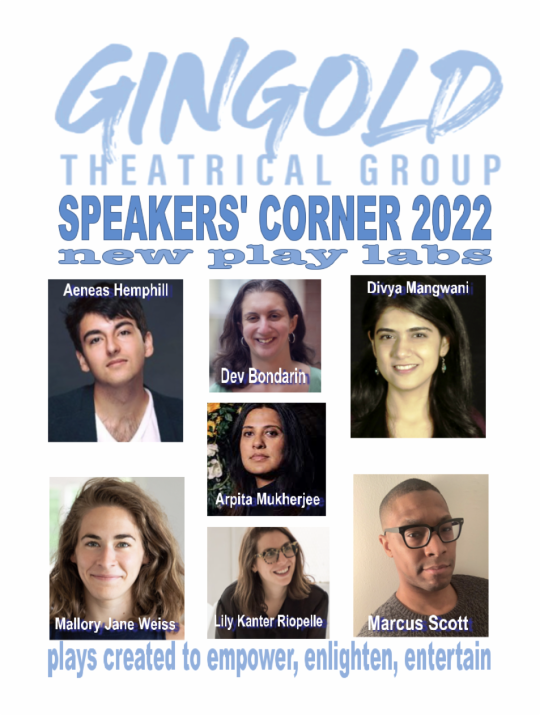
by Chloe Rabinowitz May. 18, 2022
Gingold Theatrical Group, now in its 17th Season, is continuing its new play development with the Plays-In-Progress AEA-approved Showcases of this year's SPEAKER'S CORNER Writers Group. This season, writers Aeneas Sagar Hemphill, Divya Mangwani, Marcus Scott and Mallory Jane Weiss are developing works in response to prompts from the revolutionary activist humanitarian writings and precepts of George Bernard Shaw. These Actors Equity Association approved 29-hour workshops culminate with a presentation as an opportunity for each playwright to assess where they are with their work and to determine the next steps to be taken. These invitation-only presentations will take place at ART-NY Studios (520 8th Avenue). Space for each final presentation is extremely limited and reservations must be made, so to request the opportunity to attend any of these events please email [email protected]
This year's showcases will be:
Howl From Up High
by Mallory Jane Weiss, Directed by Lily Riopelle
Thursday May 19th at 6pm
Purva Bedi, Tori Ernst, Jacqueline Guillen, Sarah Rose Kearns, Adam Langdon, Collin McConnell;
Assistant Director, Margaret Lee
Vigil-Aunties
by Divya Mangwani, Directed by Arpita Mukherjee
Friday May 20th at 7pm
Anya Banerji, Aadya Bedi, Sayali Niranjan Bramhe, Rahoul Roy, Mahima Saigal, Salma Shaw, and Rita Wolf;
Assistant Director, Sara Vishnev
There Goes The Neighborhood
by Marcus Scott, Directed by Dev Bondarin
Friday June 3rd at 7pm
Phillip Burke, Shavanna Calder, Anthony Goss, Ashley Jossell, Olivia Kinter, Monique Robinson, David Rowen, Cliff Sellers;
Stage Manager Elliot J. Cohen.
Karma Sutra Chai Tea Latte
by Aeneas Hemphill, Directed by Arpita Mukherjee,
Monday June 6th at 2pm
Shawn, Jain, Sean Devare, Salma Shaw, Khyati Sehgal, Mahima Saigal;
Stage Manager Elliot J. Cohen
"Among the many programs we've developed over the last 17 years, developing new plays with the intent to produce and publish, has always been the most ambitious dream of all of us at Gingold. While we continue to produce our annual full off-Broadway productions of plays by George Bernard Shaw, we plan to add at least one new play to our schedule to share with our devoted patrons," said David Staller.
Named after the corner of London's Hyde Park where George Bernard Shaw and other political speakers have delivered speeches since 1855, GTG's SPEAKERS' CORNER brings together six to ten writers each year who will spend the year exploring a specific Shaw play and writing individual new plays in response to that text and Shaw's forward thinking humanitarian ideals. Speakers' Corner members meet bi-monthly, and GTG will host showings of the works that Speakers' Corner develops at the end of the season. The group's members were identified through an open application process under the guidance of Becker, GTG Artistic Director David Staller, and this season's Speakers' Corner Readers and Advisory Committee: Ilana Becker, Stephen Brown-Fried, Ralph B. Peña, Daphne Rubin-Vega, Sharon Washington, along with Speakers' Corne alumni Hank Kim, and Lorenzo Roberts.
WRITERS:
Aeneas Sagar Hemphill (he/him) is an Indian-American playwright and screenwriter based in NYC and DC. Weaving through many genres, his work builds new worlds to illuminate our own, investigating the ghosts that haunt our lives and communities with passion, pathos, and humor. He was a 2019 Resident Artist with Monson Arts Center and 2017-2018 Playlab fellow at Pipeline Theatre, as well as semi-finalist for the 2019 Princess Grace Award, semi-finalist for the 2019 Mabou Mines Resident Artist Program, and finalist for the 2017 Many Voices Fellowship. His plays include: Black Hollow (Argo Collective, Dreamscape Theatre), The Troll King (Pipeline), Childhood Songs (Monson Arts), The Republic of Janet & Arthur (Amios), The Red Balloon (Noor Theatre), A Stitch Here or There (DarkHorse Dramatists, Slingshot Theatre), A Horse and a Housecat (Slingshot Theatre). MFA Playwriting, Columbia University.
Divya Mangwani is a writer and theatre artist from Pune, India, based in New York. She examines the absurdities of the social, political and mythical. Her work focuses on global identity and belonging. Divya was the founder and Artistic Director of Moonbeam Factory Theatre, where she wrote, directed, and produced plays in India, Singapore and Glasgow. In New York, she has developed work with UNICEF, Soho Rep, New York Theatre Workshop, Gingold Theatrical Group, Rattlestick Theatre, Mabou Mines, Hypokrit Theatre, The Flea, Project Y, Pipeline Theatre, Rising Sun, and Governors Island. Divya is a recent fellow of the Soho Rep Writer/Director Lab and the Gingold Theatrical Group Speakers Corner and was a NYTW 2050 Artistic Fellow, Hypokrit Theatre Tamasha playwright, Project Y Writers Group and Playlab fellow at Pipeline Theatre. Divya has also worked as a journalist and editor at The Times of India, ESPN, Crisis Response Journal, and Daily News & Analysis.
Marcus Scott is a dramatist & journalist. Selected work includes Tumbleweed (finalist for the 2017 Bay Area Playwrights Festival; semifinalist for the 2022 Eugene O'Neill Theater Center National Playwrights Conference, the 2022 Blue Ink Playwriting Award & the 2017 New Dramatists Princess Grace Fellowship Award), Sibling Rivalries (finalist for the 2021 Seven Devils Playwrights Conference; semi-finalist for the 2022 Lanford Wilson New American Play Festival, the 2021 Blue Ink Playwriting Award & the 2021 New Dramatists Princess Grace Fellowship Award) and Cherry Bomb (recipient of the 2017 Drama League First Stage Artist-In-Residence). He was commissioned by Heartbeat Opera to adapt Beethoven's Fidelio (Librettist/Co-writer; The Met Museum; NY Times Critic's Pick). Recently developed at Gingold Theatrical Group (Speaker's Corner), Zoetic Stage (Finstrom Festival Of New Work), Queens Theatre (New American Voices series) and The Road Theatre Company's Under Construction 3 Playwrights Group and Cohort 2 of the Southern Black Playwrights Lab at the Mojoaa Performing Arts Company. Scott is a 2021 NYSAF Founders' Award finalist and a 2021 Doric Wilson Independent Playwright Award semi-finalist. His articles appeared in Architectural Digest, Time Out New York, American Theatre Magazine, Playbill, Elle, Out, Essence, The Brooklyn Rail, among others. MFA: GMTWP, NYU Tisch.
Mallory Jane Weiss's plays include Big Black Sunhats (The O'Neill National Playwrights Conference 2022; Clubbed Thumb Biennial Commission finalist 2020), Lights Out and Away We Go (Clubbed Thumb reading June 2022), The Page Turners (The O'Neill National Playwrights Conference finalist 2021), Pony Up (Princess Grace Finalist 2019; SPACE on Ryder Farm semi-finalist 2020), Howl From Up High (in development with Gingold Theatrical Group), Evermore Unrest (Red Bull Short New Play Festival 2020), Dave and Julia are stuck in a tree (Playing on Air's James Stevenson Prize 2020), and Losing You, Which Is Enough (workshop readings at The Lark and Cherry Lane Theatre). She is a member of Clubbed Thumb's Early Career Writers' Group (2021-2022), The COOP's Clusterf**k vol. 2 (2021), Gingold Theatrical Group's Speakers Corner, and Fresh Ground Pepper's BRB Retreat (2019). Mallory earned her B.A. from Harvard University and her M.F.A. in playwriting from The New School. She also works as a Senior Writer for Ethena, where she creates harassment-prevention training in the form of short-form articles, graphic novels, audio plays, and more.
In addition to Speakers' Corner, GTG's on-going play development also includes PRESS CUTTINGS, which, in recognition of Shaw's career as a theatre critic, supports the development of new plays written by theatre journalists. Press Cuttings has commissioned new plays by Jeremy McCarter, Robert Simonson, and David Cote, and, in June of 2017, presented an AEA workshop of David Cote's Otherland directed by May Adrales.
This fall, GTG returned to live, in person performance with the acclaimed revival of Bernard Shaw's Mrs. Warren's Profession starring Robert Cuccioli, David Lee Huynh, Alvin Keith, Nicole King, Raphael Nash Thompson, and Tony® Award winner Karen Ziemba as Mrs. Warren, which recently completed its acclaimed Off-Broadway engagement at Theatre Row, directed by David Staller. Terry Teachout, reviewing Mrs. Warren's Profession in The Wall Street Journal, declared "Mr. Staller, who knows everything there is to know about Shaw, has not only staged the play but edited the text with his accustomed skill. All the more reason, then, to praise David Staller, the artistic director of Project Shaw, a long-running series of semi-staged concert readings of the playwright's 60-odd shows. In addition to Project Shaw, Mr. Staller's Gingold Theatrical Group presented fully staged small-scale off-Broadway versions of Heartbreak House in 2018 and Caesar and Cleopatra in 2019, and now they're doing Mrs. Warren's Profession. The production is completely satisfying... Sprinkled with tart, school-of-Wilde epigrams ('There are no secrets better kept than the secrets everybody guesses') and overflowing with glittering talk, it's a foolproof vehicle for six accomplished actors and a director who, like Mr. Staller, knows better than to let the play become a static chat-fest. Instead, he keeps the actors moving and the pace brisk, and the results are immensely pleasurable."
GINGOLD THEATRICAL GROUP creates theater that supports human rights, freedom of speech, and individual liberty using the work of George Bernard Shaw as our guide. All of GTG's programs are inspired by Shaw's humanitarian values. Through full productions, staged readings, new play development, and inner-city educational programs, GTG brings Shavian precepts to audiences and artists across New York, encouraging individuals to breathe Shaw's humanist ideals into their contributions for the future. Shaw created plays to inspire peaceful discussion and activism and that is what GTG aims to accomplish. GTG's past productions include Man and Superman (2012), You Never Can Tell (2013), Major Barbara (2014), Widowers' Houses (2016), Heartbreak House (2018), and Caesar & Cleopatra (2019). Founded in 2006 by David Staller, GTG has carved a permanent niche for the work of George Bernard Shaw within the social and cultural life of New York City, and, through the Project Shaw reading series, made history in 2009 as the first company ever to present performances of every one of Shaw's 65 plays (including full-length works, one-acts and sketches). GTG brings together performers, critics, students, academics and the general public with the opportunity to explore and perform theatrical work inspired by the humanitarian and activist values that Shaw championed. All comedies, these plays boldly exhibit the insight, wit, passion and all-encompassing socio-political focus that distinguished Shaw as one of the most inventive and incisive writers of all time. Through performances, symposiums, new play development, and outreach, as well as through our discussion groups and partnerships with schools including SUNY Stony Brook, Regis, the De La Salle Academy, and The Broome Street Academy, GTG has helped spark a renewed interest in Shaw across the country, and a bold interest in theater as activism. Young people are particularly inspired by Shaw's invocation to challenge the strictures society imposes, to embrace the power of the individual, to make bold personal choices and to take responsibility for these choices. GTG's new play development lab, Speakers' Corner, created to support playwrights inspired by Shaw's ideals, is now in its second cycle. Through monthly prompts and feedback, writers develop work inspired by or in response to a specific Shaw text. Plays developed through Speakers' Corner will be nurtured in workshops and readings with the expectation that GTG will publish or produce them. GTG encourages all people to rejoice in the possibilities of the future. All of GTG's programming is designed to inspire lively discussion and peaceful activism with issues related to human rights, the freedom of speech, and individual liberty. This was the purpose behind all of Shaw's work and why GTG chose him as the guide toward helping create a more tolerant and inclusive world through the exploration of the Arts.
For more information about the Workshops or any of Gingold Theatrical Group's projects, please call 212-355-7823, email [email protected], or visit online at www.gingoldgroup.org.
#Gingold Theatrical Group#GTG#Speakers' Corner#Mallory Jane Weiss#Divya Mangwani#Aeneas Hemphill#Arpita Mukherjee#Lily Riopelle#Dev Bondarin#Marcus Scott#MarcusScott#WriteMarcus#Write Marcus
2 notes
·
View notes
Text
Toscano’s entire book can be read as a taxonomy of fascism, but he comes closest to a working definition in his discussion of German philosopher Ernst Bloch’s “Heritage of Our Times,” a “protean, fascinating and unsettling work” first published in 1935 but not available in English until 1991, which seems startlingly germane to the contemporary moment. Writing near the beginning of the Nazi regime, Bloch understood fascism as a “perverted utopian promise,” in Toscano’s phrase, with a strange relationship to time and history. That promise appeals most strongly to social groups who find themselves “somehow out of sync with the rationalizing present of capitalism,” offering them a fraudulent reactivation of “unfulfilled pasts and unrealized presents.”
That strikes me as an almost perfect description of Trump’s most loyal supporters: As reams of social-science research have confirmed, they are not necessarily poor or unemployed or economically struggling in any objective sense — but they clearly perceive themselves as “out of sync” with the dominant social order, and feel enraged or cheated out of something they cannot define but believe they deserve.
Also, this:
Toscano’s deeper point, although he doesn’t exactly put it this way, is that “democracy” and “fascism” exist on a continuum. They share the same fundamental conception of individual or “bourgeois” liberty, ultimately drawn from the likes of John Locke, Adam Smith and Edmund Burke (all of whom would no doubt be horrified by every aspect of 21st-century politics). It’s self-flattering nonsense to treat them as binary states of light and darkness, or to resort to idiotic metaphors about America’s sacred democracy teetering on the edge of a bottomless abyss.
0 notes
Text
Hot/Badass "Priest" Cinematic Universe
We're going to Hell but good lord look at these men-
1. Father Paul Hill : Midnight Mass
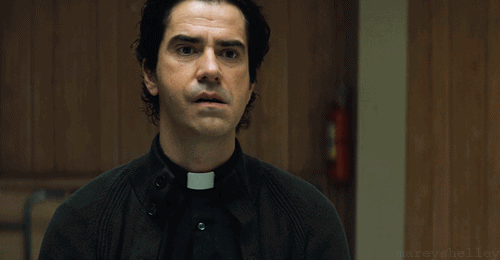
2. Father Marcus Keane : The Exorcist (show)
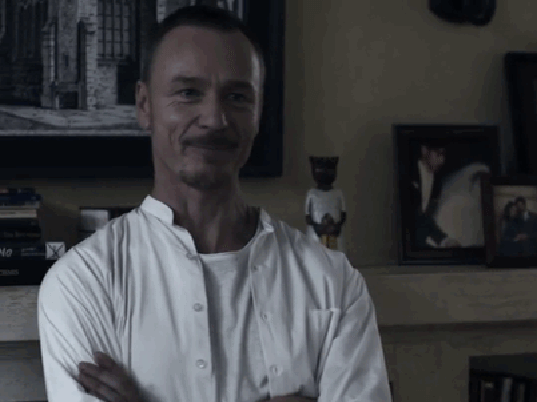
3. The Priest : Fleabag

4. Father Damien Karras : The Exorcist (movie)

5. Camerlengo Patrick McKenna : Angels & Demons
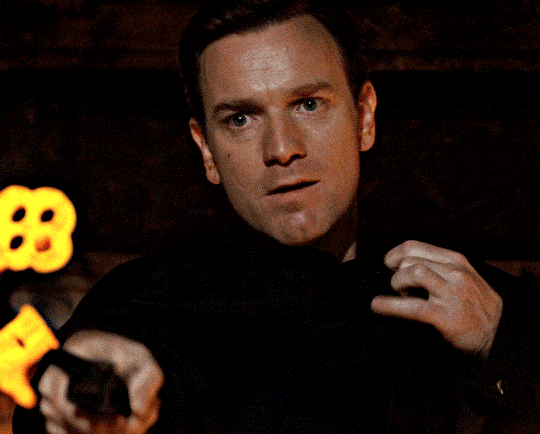
6. Father Andrew Kiernan : Stigmata

7. Pastor Ernst Toller : First Reformed

8. Father Antonio : Intruders

Honorable Mentions:
9. Father Burke : The Nun

10. Tomas Ortega : The Exorcist (show)
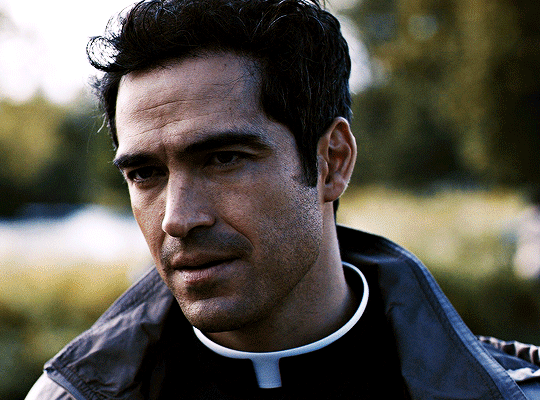
#hot priest#hot priests#father damien karras#damien karras#the exorcist#the nun#father burke#stigmata#father marcus keane#marcus keane#father tomas ortega#tomas ortega#fleabag#priest#intruders#father antonio#father andrew kiernan#first reformed#angels & demons#camerlengo patrick mckenna#father paul hill#midnight mass#father paul#monsignor pruitt#hamish linklater#ewan mcgregor#daniel brühl#daniel bruhl#ben daniels#andrew scott
358 notes
·
View notes
Photo
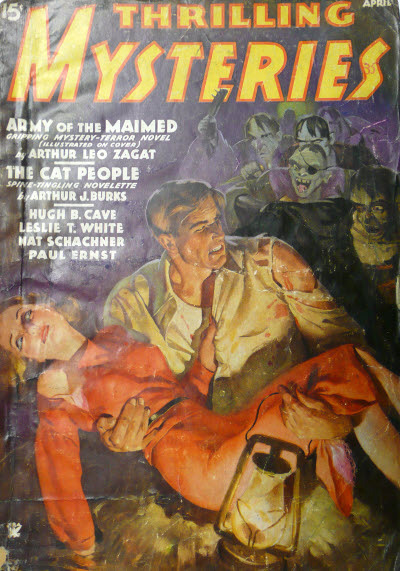
philsp.com
April 1935 issue
cover by Emery Clarke
Arthur Leo Zagat, “Army of the Maimed"
Paul Ernst, “Death’s Portrait"
Leslie T. White, “Dogs of Death"
Hugh B. Cave, “Horror in Wax"
Nat Schachner, “Satan’s Antechamber"
Arthur J. Burks, “The Cat People"
Seattle Mystery Bookshop
#thrilling mysteries magazine#emery clarke#pulp art#pulp cover#pulp magazine#hardboiled#crime fiction#mystery short stories#arthur leo zagat#paul ernst#leslie t. white#hugh b. cave#nat schachner#arthur j. burks
6 notes
·
View notes
Text
Canon LGBTQ+ DC Comics Characters
(only doing Prime Earth, but if y’all want I can do different Earth’s too)
Akila of Bana-Mighdall (Akila) Lesbian
Albert Caldecott Bisexual
Alpha Centurion (Roman) Gay
Alysia Yeoh Transgender/Bisexual
Anaya Lesbian
Apollo (Phoebus Apollo) Bisexual
Apollo (Andrew Pulaski) Gay
Aqualad (Jackson Hyde) Gay
Artemis or Bana-Mighdall (Artemis) Bisexual
Atlantiades Transgender
Batwoman (Katherine Kane) Lesbian
Bellacheck Temple Gay
Berenice Yoon MilonasBisexuall
Bolt (Lawrence Bolatinsky) Gay
Brain (Ernst) Bisexual
Bride (Bride of Frankenstein) Bisexual
Bunker (Miguel Barragan) Gay
Burden (Christopher) Gay
Burke Day Transgender
Caden Zapote Gay
Cameron Chase Lesbian
Carver Colman Gay
Casey Brinke Bisexual
Casey Klebba Gay
Catman (Thomas Blake) Bisexual
Catwoman (Selina Kyle) Bisexual
Catwoman (Eiko Hasigawa) Lesbian
Colton Rivera Gay
Crush (Xiomara Rojas) Lesbian
Dale Gunn Gay
Danny the Street Transgender
David Singh Gay
Derinoe Lesbian
Dez Trevius Gay
Diane MeadeBisexual
Djinn II Bisexual
DNA Non-Binary
Doctor Ikon (David Isherwood) Gay
Exoristos Lesbian
Francine CharlesBisexual
Frederick HemsleyBisexual
Green Lantern (Kaja Dox) Lesbian
Harley Quinn (Harleen Quintal) Bisexual
Harley Sinn (Constance Brand) Lesbian
Harvey Quinn (Harvey McPherson) Gay
Hellblazer (John Constantine) Bisexual
Hippolyte Bisexual
Icicle (Cameron Mahkent) Gay
Io Lesbian
Jane Whitecrest (Jane Stepford) Bisexual
Jeanette Bisexual>l
Jinny Hex Lesbian
Jo Lesbian
John Troughton Gay
Julia Perry (Julia Pennyworth) Bisexual
Knife (Tahani) Lesbian
KnockoutBisexual
March Harriet (Harriet Pratt) Bisexual
Margaret Sawyer Lesbian
Maxima Lesbian
Midnighter Gay
Miki Transgender
Mother Panic (Violet Paige) Bisexual
Neon the Unknown (Colin Nomi) Bisexual
Nick Necro (Nicolas Nolan) Bisexual
Nightmare Nurse (Asa) Bisexual
Nocturna (Natalia Mitternacht) Bisexual
OliverBisexual
Orange Lantern (Glomulus) Asexual
Otto Haddon Gay
Pado Swakatoon Transgender
Philippus Lesbian
Pied Piper (Hartley Rathaway) Gay
Poison Ivy (Pamela Isley)Bisexual
Porcelain (Kani) Transgender/Bisexual/Non-Binary
Primaa Lesbian
Prometheus Gay
Rainmaker (Sarah Rainmaker) Bisexual
Red Phantom (Michael Drown) Gay
Roberto Diaz Gay
Safiyah Sohail Lesbian
Scandal Savage Lesbian
Scream Queen (Nina Skorzeny) Lesbian
Shade (Loma Shade) Bisexual
Shade (River Johnson) Bisexual
Shay Veritas Lesbian
Shining Knight (Ystin) Transgender
Sophie Moore Lesbian
Stallion (Randy Harrahan) Gay
Starling (Evelyn Crawford) Bisexual
Starman (Mikaal Tomas) Gay
Steel (Natasha Irons) Lesbian
Suditi Varma Lesbian
Tasmanian Devil (Hugh Dawkins) Gay
Terry None Lesbian
Tonya Lu Lesbian
Traci 13 (Traci Thirteen) Lesbian
Tremor (Rossana Chatterji) Asexual
The Aerie Non-Binary
The Question (Renee Montoya) Lesbian
The Ray (Raymond Terrill) Gay
Victoria October Transgender
Virtue (Holly Ann Fields) Lesbian
Weston Toomey Bisexual
Wolf Spider (Evan Blake) Gay
Wonder Woman (Diana Prince) Bisexual
Xenos Gay
Ya’Wara Bisexual
#I did it! Holy shit the gradient took so long.#dc comics#pride#homosexual#gay#lesbian#transgender#non-binary#asexual#dc comics pride#lgbtq#prime earth#dc comics list
533 notes
·
View notes
Text



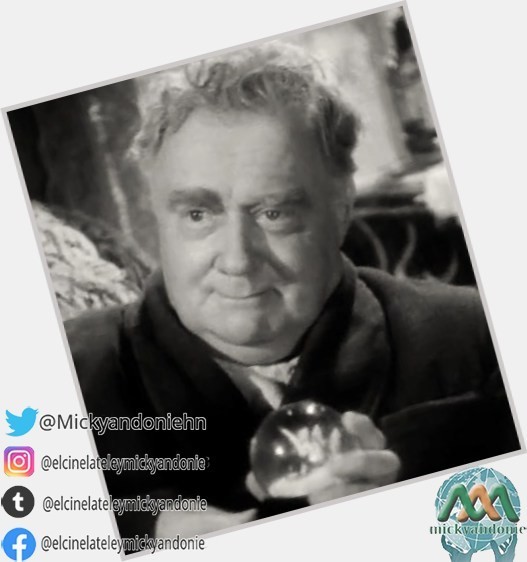
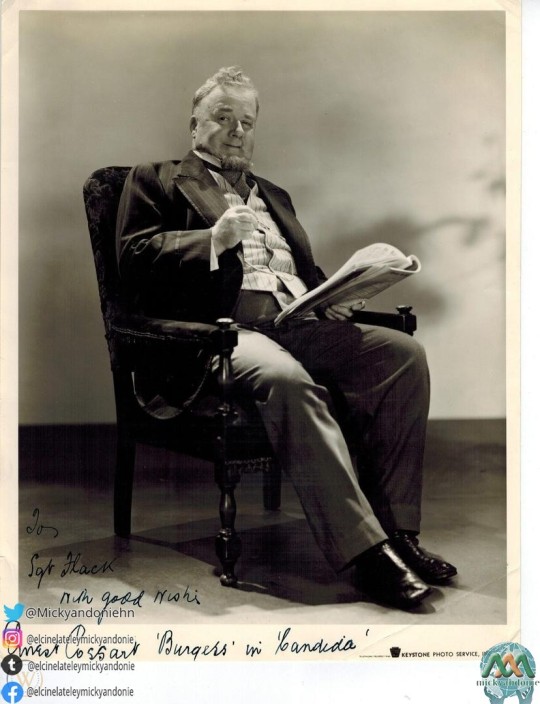
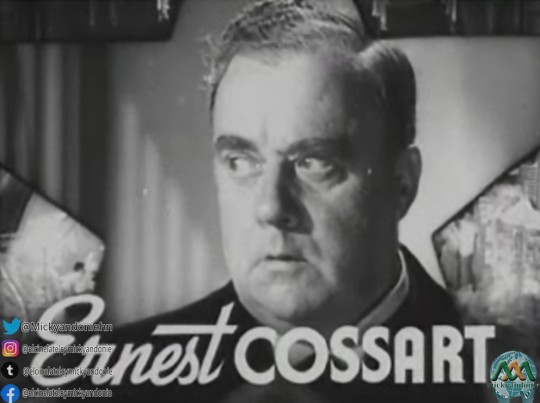
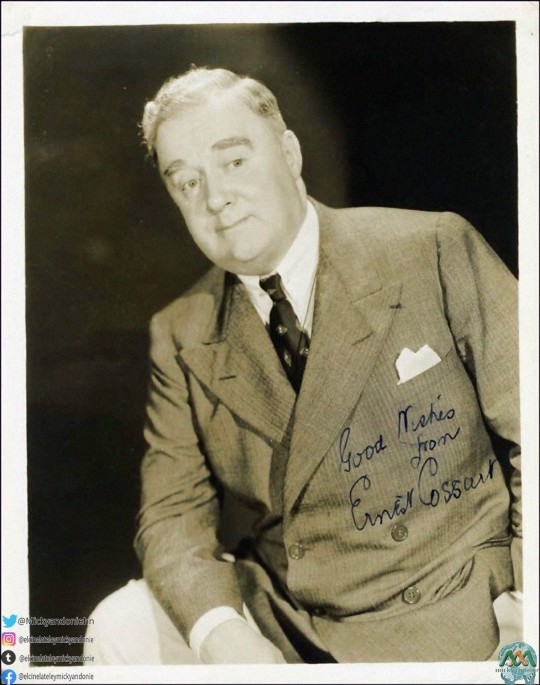


Ernest Cossart.
Filmografía
Cine
1916: The Pursuing Vengeance, de Martin Sabine.
1935: The Scoundrel, de Ben Hecht y Charles MacArthur.
1936: El gran Ziegfeld, de Robert Z. Leonard.
1936: Three Smarts Girls, de Henry Koster.
1936: Murder with Pictures, de Charles Barton.
1937: Angel, de Ernst Lubitsch.
1937: Champagne valse, de A. Edward Sutherland.
1939: Zaza, de George Cukor.
1939: Tower of London, de Rowland V. Lee.
1939: Three Smart Girls Grow Up, de Henry Koster.
1939: The Light that Failed, de William A. Wellman
1939: Lady of the Tropics, de Jack Conway.
1940: Kitty Foyle, de Sam Wood.
1940: Tom Brown's School Days, de Robert Stevenson.
1941: Skylark, de Mark Sandrich.
1942: Kings Row, de Sam Wood.
1945: Love Letters, de William Dieterle.
1945: Tonight and every Night, de Victor Saville.
1946: Cluny Brown, de Ernst Lubitsch.
1946: The Jolson Story, de Alfred E. Green
1947: Love from a Stranger, de Richard Whorf.
1949: John Loves Mary, de David Butler.
Teatro (Broadway)
1908: The Girls of Gottenberg, música de Ivan Caryll y Lionel Monckton, letras de Adrian Ross y Basil Hood.
1910: Mrs. Dot, de William Somerset Maugham, con Billie Burke.
1910: Love among the Lions, de Winchell Smith a partir de F. Anstey, con Ivan F. Simpson
1911: The Zebra, de Paul M. Potter a partir de Marcel Nancey y Paul Armont.
1912: The Typhoon, de Emil Nyitray y Byron Ongley a partir de Menyhert Lengyel.
1914: Marrying Money, de Washington Pezey y Bertram Marbugh.
1915: Androcles and the Lion, de George Bernard Shaw.
1915: The Man who married a Dumb Wife, de Anatole France, con Isabel Jeans.
1915: El sueño de una noche de verano, de William Shakespeare, con Isabel Jeans.
1915: The Doctor's Dilemma, de George Bernard Shaw.
1915: Sherman was right, de Frank Mandel.
1920-1921: The Skin Game, de John Galsworthy.
1921: The Title, de Arnold Bennett, interpretada y dirigida por Lumsden Hare.
1922: HE Who gets slapped, de Leónidas Andreiev, adaptada por Gregory Zilboorg, con Richard Bennett, Margalo Gillmore, Edgar Stehli, Henry Travers y Helen Westley.
1922: From Morn to Midnight, de Georg Kaiser, adaptada por Ashley Dukes, con Allyn Joslyn, Edgar Stehli, Henry Travers y Helen Westley.
1922-1923: Seis personajes en busca de autor, de Luigi Pirandello, adaptada por Edward Storer, con Florence Eldridge.
1923: The Love Habit, adaptación de Gladys Unger a partir de Pour avoir Adrienne, de Louis Verneuil, con Florence Eldridge.
1923: Casanova, de Lorenzo De Azertis, adaptada por Sidney Howard.
1923-1924: Santa Juana, de George Bernard Shaw, con Henry Travers.
1924: Seis personajes en busca de autor.
1924: The Steam Roller, de Laurence Eyre.
1924-1925: Cándida, de George Bernard Shaw, con Pedro de Cordoba.
1925-1926: Arms and the Man, de George Bernard Shaw, con Pedro de Cordoba y Henry Travers.
1926: The Chief Thing, de Nikolaï Evreinov, adaptada por Leo Randole y Herman Bernstein, con Romney Brent, Edward G. Robinson, Lee Strasberg, Henry Travers y Helen Westley.
1926-1927: Loose Ankles, de Sam Janney.
1926-1927: What never dies, de Alexander Engel, adaptada por Ernest Boyd.
1927-1928: The Doctor's Dilemma, de George Bernard Shaw, con Margalo Gillmore, Alfred Lunt, Henry Travers y Helen Westley.
1928: Marco Millions, de Eugene O'Neill, escenografía de Rouben Mamoulian, con Robert Barrat, Albert Dekker, Margalo Gillmore, Alfred Lunt, Vincent Sherman y Henry Travers.
1928: Volpone, de Ben Jonson, adaptada por Ruth Langner, con Albert Dekker, Margalo Gillmore, Alfred Lunt, Vincent Sherman, Henry Travers y Helen Westley.
1928-1929: Caprice, de Philip Moeller, con Douglass Montgomery.
1929: Becky Sharp, de Langdon Mitchell, a partir de La feria de las vanidades, de William Makepeace Thackeray, con Etienne Girardot, Arthur Hohl, Basil Sydney y Leonard Willey.
1930: The Apple Cart, de George Bernard Shaw, con Violet Kemble-Cooper, Tom Powers, Claude Rains y Helen Westley.
1930: Milestones, de Arnold Bennett y Edward Knoblauch, con Beulah Bondi y Selena Royle.
1931: Getting Married, de George Bernard Shaw, con Romney Brent, Dorothy Gish, Henry Travers y Helen Westley.
1931: The Way of the World, de William Congreve, con Walter Hampden, Gene Lockhart, Kathleen Lockhart, Selena Royle y Cora Witherspoon.
1931: The Roof, de John Galsworthy, con Henry Hull y Selena Royle.
1932: The Devil passes, de Benn W. Levy, con Eric Blore, Arthur Byron, Mary Nash y Basil Rathbone.
1932: Too true to be good, de George Bernard Shaw, escenografía de Leslie Banks, con Leo G. Carroll y Claude Rains.
1933: The Mask and the Face, de W. Somerset Maugham, con Leo G. Carroll y Humphrey Bogart
1933-1934: Mary of Scotland, de Maxwell Anderson, con Helen Hayes, Edgar Barrier, George Coulouris, Philip Merivale, Moroni Olsen y Leonard Willey.
1935: Accent on Youth, de Benn W. Levy
1937: Madame Bovary, de Benn W. Levy, a partir de Gustave Flaubert, con Eric Portman y O. Z. Whitehead.
1945: Devils Galore, de Eugene Vale.
1948: The Play's the Thing, de Ferenc Molnár, adaptada por P. G. Wodehouse, con Louis Calhern, Francis Compton y Faye Emerson.
1949: The Ivy Green, de Mervyn Nelson, con Hurd Hatfield.
Créditos: Tomado de Wikipedia
https://es.wikipedia.org/wiki/Ernest_Cossart
19 notes
·
View notes
Text
Back to Hogwarts 2022 Challenge.
Day 1: The journey to Hogwarts.
A/N: Hello everyone and welcome to the back to Hogwarts challenge hosted by the incredible @cursebreakerfarrier. For this chapter, we're going for something related to my OC Ernst Burke (whose profile will be published soon) and his first journey to Hogwarts. Hope you guys like it 😊😊
Summary: It was soon to be September of the year 1890. An eventful month for the Burke family as it is the year when the oldest son of the house heads to Hogwarts for the start of his journey there. But how does he, Ernst Burke, feel about it?
Warnings: Pureblood prejudices and tats pretty much it
It was August 31st, 1890.
In the huge estate of a certain affluent household of pureblood wizards known as the Burkes, one could see from the window of the study room in the east wing, a child sitting by the window sill, writing intently in his diary.
This Child was no ordinary child. While certainly not of an exclusive type amongst the wizards, he would soon grow to be one of the most eligible bachelors in the upper-class English society including the Wizarding Society.
He was Ernst Burke, heir to the prestigious and ancient Pureblood House of Burke. It was a big deal, and everyone seemed to know that, making it an even bigger deal for Ernst as he knew everyone had huge expectations for him.
His father Aurelian, had made sure to drill into his mind the huge expectations he had for him. Every waking moment for Ernst was different for him than that of his sisters and brother. But he seemed to always be very calm and collected about his responsibilities, always appearing confident and comfortable in his position.
The truth was he never really was. While he was confident about his capabilities, he also doubted his decisions. Whether it was the smallest of things or a huge responsibility, Ernst would think it through deeply. Just as he was doing at this moment.
He sat at his writing desk, writing intently in his diary, pouring out his deepest thoughts and feelings. Ernst usually spoke less but that didn't mean he hadn't got a lot of deep thoughts, actually on the contrary.
"Dear Diary," he wrote.
It seems that everyone except me is in quite a frenzy about tomorrow. All the servants and staff were busy packing food and my luggage for my time at Hogwarts School of Witchcraft and Wizardry.
How do I feel? Well for one I am excited to finally not be under the constant scrutiny of my parents and tutors and for once be rebellious. But more than that, I'm excited to widen my horizons, meet people of different kinds, understand magic and understand myself.
I'm ready for Hogwarts and I'm ready to face the challenge that comes with it.
And with that, Ernst let out a sigh, finally feeling at ease, and closed his diary. He tucked it under his shoulder and headed to his room for a good night's sleep
5 notes
·
View notes
Text
K you can now reblog. If you find places to read any stories without links as actual text for free, please let me know!
1933
January 1933
Under Arctic Ice by Harry Bates
The Floating Island of Madness by Jason Kirby
The Fifth-Dimension Tube by Murray Leinster
March 1933
Salvage in Space by Jack Williamson
Lords of the Stratosphere by Arthur Josephus Burks
The End of Time by Wallace West
The Death-Traps of FX-31 by Sewell Peaslee Wright
Wanderer of Infinity by Harl Vincent
Invasion by Murray Leinster
October 1933 (PDF)
The Orange God by Nat Schachner
A Race Through Time by Donald Wandrei (PDF)
Burroughs Passes by Kenneth James
Anything Can Happen! by Peter Gordon
From the Wells of the Brain by Paul Ernst
Don MacKinder's Model by F. S. Howard-Burleigh
The Coffin Ship by Desmond Winter Hall
Fire Imps of Vesuvius by Nat Schachner
Ping-Ting by Charlton Lawrence Edholm
Where Four Roads Met by Gladys St. John-Loe
Callahuaya's Curse by P. H. Fawcett
November 1933 (PDF)
Beyond the Sphinxes' Cave by Murray Leinster
The Lovely Ghost by Stuart Jackson
Prisms of Space by Robert H. Leitfred
In the Shadow of the Tii by D. W. Hall [as by Ainslee Jenkins]
Dead Star Station by Jack Williamson
The Man from Cincinnati by Holloway Horn
Plane People by Wallace West
My Lady of the Tunnel by Arthur J. Burks
Telegraph Plateau by Harl Vincent
December 1933 (PDF)
Land of the Lost by Charles Willard Diffin
The Machine that Knew Too Much by A. T. Locke
The Invading Blood Steam by Paul Starr
The Purple Brain by Hal K Wells
Ancestral Voices by Nat Scachner
Last Sacrifice by J. Gibson Taylor Jr.
Farewell to Earth by Donald Wandrei
Terror Out of Time by Jack Williamson
The Demon of the Flower by Clark Ashton Smith
#Rjalker compiles Astounding Stories of Super-Science#free books#public domain#public domain stories
3 notes
·
View notes
Text
Bibliografía
Baxandall, Michael. “Alberti y los humanistas: la composición” en Giotto y los oradores. La visión de la pintura en los humanistas italianos y el descubrimiento de la composición pictórica (1350-1450). 2 ed. Traducción del inglés de Aurora Luelmo; del latín de Antonio Gascón; del griego de Luis M. Macía. Madrid: La balsa de la Medusa, 2010.
Borgo, Francesca. “Leonardo legge Vitruvio.” En Leonardo e Vitruvio. Oltre il cerchio e il quadrato. Venezia: Marsilio Editori, 2019.
Burke, Peter. “Del Renacimiento a la Ilustración” en Comprender el Pasado: Una historia de la escritura del pensamiento histórico, editado por Aurell et al.
Black McHam, Sarah. “Pliny’s Influence on Vasari’s First Edition of the “Lives”.” Artibus et Historiae 32, n° 64 (2021), 9-23.
Cast, David J. (ed.) The Ashgate Research Companion to Giorgio Vasari. Burlington: Ashgate, 2014.
Clarke, Georgia. “Vitruvian Paradigms”. Papers of the British School at Rome 70 (2002), 319-346.
Cunnally, John. “Leonardo and the Horses of Nero”. The Burlington Magazine 130, n° 1026 (1988), 689-690.
Didi-Huberman, Georges. “La Imagen-matriz. Historia del arte y genealogía de la semejanza.” En Ante el tiempo. Historia del arte y anacronismo de las imágenes [2000]. Traducción de Antonio Oviedo. Buenos Aires: Adriana Hidalgo editora, 2011.
Forty, Adrian. “First translation of Vitruvius’ De Architecture in Italian” en Treasures form UCL, editado por Gillian Furlong.
Ginzburg, Carlo. “Huellas. Raíces de un paradigma indiciario”. Mitos, emblemas, indicios. Morfología e historia. Barcelona: Gedisa, 1989.
Gombrich, Ernst. “Tradition and Innovation: The Later Fifth Century in Italy” y “Harmony attained: Tuscany and Rome, Early Sixteenth Century” en Story of Art.
Halliwell, Stephen. The Aesthetics of Mimesis: Ancient Texts and Modern Problems. Princeton y Oxford: Princeton University Press, 2002.
Hardwick, Lorna and Classical Association. Reception studies. Oxford: OUP, 2003.
Land, Norman E. “Leonardo da Vinci and Apelles”. Notes in the History of Ar 25, n°2 (2006), 14-17.
Martínez, J. Rafael. “Acordes vitruvianos en Leonardo”. Interdisciplina 8, n°21 (2020), 47-74.
Porter, James I. “Disfigurations: Erich Auerbach’s Theory of Figura.” Critical Inquiry 44 (2017), 80-113.
Russell Ascoli, Albert (Editor). “Boccaccio’s Auerbach: Holding the Mirror up to Mimesis” en A Local Habitation and a Name: Imagining Histories in the Italian Renaissance. Nueva York: Fordham University Press, 2011.
Sverlij, Mariana. “Retórica y arquitectura: De Re Aedificatoria de Leon Battista Alberti”. Rétor 4, n°2 (2014), 200-219.
Yerkes, Carolyn. "Building in Theory and Practice" en A Companion to Renaissance and Baroque Art, editado por Babette Bohn y James Saslow. Chichester: Wiley-Blackwell, 2013.
Zak, Gur. “Humanism as a Way of Life: Leon Battista Alberti and the Legacy of Petrarch”. I Tatti Studies in the Italian Renaissance 17, n°2 (2014), 217-240.
2 notes
·
View notes
Photo
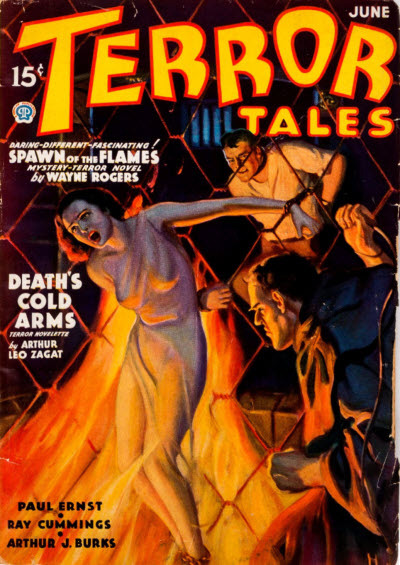
“Terror Tales” June 1936 cover by John Newton Howitt
Spawn of the Flames by Wayne Rogers
Lady from Hell by Henry Treat Sperry
They Call Me Killer by Arthur J. Burks
Guests of the Lovely Dead by Paul Ernst
I Sleep with Terror! by Ray Cummings
Death’s Cold Arms by Arthur Leo Zagat
14 notes
·
View notes
Text
‘Tis the season to spread cheer and I’m doing my part by recommending classic movies, paying them forward in hopes that these memorable distractions take people’s minds off negative goings on. I’m asking that you join me, recommend your favorites and #PayClassicsForward on your blogs, by noting your recommendations in the comments or sharing across social media.
Let’s give the gift of movies.
Here’s the challenge…pick movie recommendations to the “12 Days of Christmas” theme as I’ve done below. Keep in mind that movie choices should be those you think would appeal to non-classics fans. Let’s grow our community and #PayClassicsForward
Have fun!
On the first day of Christmas, etc. etc…
One hat
The “one” listing is always a difficult one due to the fact that classics lend themselves to plenty of choices. That said, I came up with a category that encompasses important decades and several genre of film – the fedora. By following the history of the fedora in film you’ll be made privy to the best gangsters, greatest funny men, and most memorable lovers of Hollywood’s golden age. So here it is, a signature fedora:
Note that in researching my favorite fedora portrait I learned that trilbys are often mistaken for fedoras. Since experts seem to be confused between the two types of classic men’s hats that leaves little hope for me. I can’t say for sure whether Bogart is wearing a trilby in the above image, but he may well be. Descriptions of this type of hat explain the rims are shorter than your average fedoras. Either way, it’s a cool, suave look and Bogie rocks it.
From GQ: What’s the difference between a fedora and a trilby?
Answer: Traditionally a fedora has a wide brim and in the UK a wide ribbon band and bow. A trilby has a narrow brim and narrow ribbon, although there are some American trilbies that still have the wide ribbon.
Two Fairbanks
Things were not simple between Douglas Fairbanks and Douglas Fairbanks, Jr. as it is for many families, but the son wore his father’s name proudly. I chose this father and son combination because if you watch their films you’ll get a healthy helping of everything from silent adventure to pre-code delicacies through some terrific television work. These are careers worth following.
Three Trios
There are quite a few choices for memorable trios in film including Cattle rustlers Robert Hightower (John Wayne), Pedro “Pete” Rocafuerte (Pedro Armendáriz), and William Kearney (Harry Carey, Jr.) in John Ford’s 3 Godfathers. That one is definitely difficult to pass up. That said, I think the following trios are likely to be looked at less by casual fans and they all deserve attention. These are my choices of trios in movies:
They are such a joy to behold. I remember them fondly from my days as a child watching them on TV. It seemed then that they appeared in a million movies, but that wasn’t the case. Still, these siblings are a joy in films like Buck Pirates with Abbott and Costello and their film debut in Albert S. Rogell’s Argentine Nights (1940). The Andrews Sisters made 17 films, more than any other singing group and all are a terrific way to be introduced to the movies. If that record does not impress you, then maybe this one will: LaVerne, Maxene, and Patty garnered 113 charted Billboard hits with 46 of those reaching the top 10. That’s more than Elvis Presley or The Beatles.
youtube
I have nothing against Disney. In fact, I enjoy their classic animated films immensely. Due to that I’m less than enthusiastic about their constant remakes, which – in my opinion – disrespects those wonderful, older film accomplishments. Today I pay tribute to one of them by way of a trio of glorious characters made in the memorable Disney vein we’ve all come to know and love, that combination of warmth and delightful comedy that permeate those wonderful films. These characters are Princess Aurora’s three good fairy godmothers Flora, Fauna and Merryweather in Disney’s 1959 classic Sleeping Beauty. They alone pay tribute to an enchanting legacy.
“Each of us the child may bless, with a single gift no more, no less.”
The final mention here goes to three Russian envoys who have arrived in Paris to sell a fortune in jewelry, imperial jewelry, the money of which is to go to the Russian government, which is in need of cash. The three, Iranoff, Buljanoff and Kopalski (played hilariously by Sig Ruman, Felix Bressart and Alexander Granach, respectively) who are supposed to be doing work for the Russian government, immediately get caught up in the excesses of capitalism and fail to sell the jewelry. Moscow then sends a special envoy to Paris to investigate what’s going on with the trio and the jewelry. The envoy is the rigid and humorless, Comrade Yakushova – Ninotchka (Greta Garbo). The charming Melvyn Douglas plays Ninotchka’s love interest in Ernst Lubitsch’s delightful comedy, but it’s the three envoys in the hands of Ruman, Bressart and Granach that make this movie among the greats in the annals of comedy. I just want to get to know them better and so should you.
Ninotchka with Iranoff, Buljanoff, and Kopalski
Four Skippy Performances
It’s no wonder this wire-haired terrier was the highest paid canine star of his day. Often referred to as “Asta,” thanks to his successful appearances in The Thin Man movies, his real name was Skippy – and we love him to tears. Although I’m choosing only four of his film performances, Skippy never made a bad movie and starred opposite some of Hollywood’s biggest names. If you keep an eye out for Skippy’s filmography on TCM, you will no doubt be introduced to an astounding talent as well as a terrific movie. It’s guaranteed. My Skippy suggestions are:
Skippy as Asta in The Thin Man movies opposite William Powell and Myrna Loy as Nick and Nora Charles. I can’t imagine you haven’t seen The Thin Man (1934), but may not have given any of the sequels a try. If that’s the case you will be delighted by Skippy in any one of his key performances:
in ANOTHER THIN MAN
in AFTER THE THIN MAN
Skippy is wonderful as Mr. Smith in The Awful Truth. Worth a custody dispute between Warriner and Warriner played by Cary Grant and Irene Dunne, this time Skippy is required to add straight drama to his repertoire as he is required to choose between his two humans right off the bat. There’s also plenty for him to do on the comedy front, however, so this one is a must-see.
forced to choose between the Warriners in court
front and center in the awful truth
Skippy as George in Howard Hawks’ Bringing Up Baby opposite Katharine Hepburn and Cary Grant. Another terrific outing for our favorite pooch as he is central to action thanks to his burying abilities.
Holding his own in Hawks’ beloved screwball
This sequel to Norman Z. McLeod’s 1937 hit Topper lacks some of the charm of its predecessor, but the talents of Constance Bennett, Roland Young, Billie Burke, Alan Mowbry, and Skippy make it well worth your time. Here, Skippy matched Bennett’s ghostly wit by ghostly wit in a role that stretches his talents to matters beyond this world and he approaches it with signature enthusiasm.
so famous he made it into this spectacular publicity photo with Constance Bennett
Five Lords-a-leaping
No explanation needed.
Cagney
Nicholas Brothers
Kelly
Astaire
Six Vivien Leigh GWTW Tests
Gone With the Wind is celebrating its 80th anniversary on December 15 and, as the biggest, most famous movie ever made, it deserves at least a mention here.
On that day in 1939, Atlanta’s Loew’s Grand Theater was buzzing with Hollywood’s biggest names. It was such an occasion for Atlanta that the film’s opening was a 3-day event as Governor Eurith Dickinson Rivers declared a three-day holiday. Other politicians asked that Georgians dress in period clothing. A lot had happened in Hollywood leading up to that premiere though including the famous search for the film’s leading lady, the protagonist of Margaret Mitchell’s 1936 blockbuster novel, Scarlett O’Hara. Every female star it seems auditioned for the part. Among them were Bette Davis, Jean Arthur, Tallulah Bankhead, Joan Bennett, Claudette Colbert, Frances Dee, and Paulette Goddard who, as stories go, was close to being chosen. As we all know, however, Scarlett went to the lovely, British Vivien Leigh who possessed an outstanding talent. Leigh made the part her own and, along with the film, became tantamount to Hollywood royalty. To honor Vivien Leigh and her memorable Scarlett O’Hara here are six make-up and wardrobe test stills:
Seven Justices
Judge James K. Hardy in the Andy Hardy movie series
Judge Margaret Turner in The Bachelor and the Bobby-Soxer
Judge Taylor in To Kill a Mockingbird
Judge Weaver in Anatomy of a Murder
Judge Henry X. Harper in Miracle on 34th Street
Judge Dan Haywood in Judgment at Nuremberg
Judge Chamberlain Haller in My Cousin Vinny
Eight Serials
Follow the links to watch episodes of these dramatically exciting serials. It might take a few chapters for you to get hooked, but you’ll get hooked.
The Perils of Pauline (1914) starring Pearl White
The Vanishing Legion (1931) starring Harry Carey and Edwina Booth
The Green Hornet (1940) starring Gordon Jones
Zorro Rides Again (1937) starring John Carroll
The Master Mystery (1918) starring Harry Houdini
Flash Gordon (1936) starring Buster Crabbe
The Phantom Creeps (1939) starring Bela Lugosi
Holt of the Secret Service (1941) starring Jack Holt
Nine Ladies Dancing
Ann Miller
Ruby Keeler
Eleanor Powell
Lena Horne
Betty Grable
Vera-Ellen
Cyd Charisse
Ginger Rogers
Dorothy Dandridge
Ten Directors
Watch their movies… live, love, learn, and laugh.
Michael Curtiz
Akira Kurosawa
William Wyler
Fritz Lang
Ernst Lubitsch
John Ford
Alfred Hitchcock
Mervyn LeRoy
Ida Lupino
Lois Weber
Eleven Movies about Millionaires
Since I recommended movies about hobos in a previous year, I thought the time came for millionaires. There are many wonderful movies about the super rich, particularly during the Great Depression when audiences loved seeing the plight of these people play out for laughs. That theme made for some of film history’s best screwball comedies. The super rich, however, have lent themselves for entertaining movie fare ever since the movies began and in every genre. Check out this terrific list from Forbes spotlighting millionaires in movies.
As for me, I have quite a few favorites with millionaire themes that appeal to most others as well. These include such popular titles as The Philadelphia Story, the shenanigans of the Charleses in The Thin Man movies, My Man Godfrey, The Lady Eve, How to Marry a Millionaire, and movies featuring recognizable names like Charles Foster Kane and Bruce Wayne. For this purpose, however, I recommend lesser known, but worthy millionaire movie stories I’ve watched through the years – some in terrible condition, a few greats, and some for plain ole fun. Here are the 11 rich and classic…
Phil Rosen’s Extravagance (1930)
John G. Adolfi’s The Millionaire (1931)
Clarence G. Badger’s Miss Brewster’s Millions (1926)
Frank Tuttle’s Love Among the Millionaires (1930)
Mitchell Leisen’s Easy Living (1937)
Anthony Asquith’s The Millionairess (1960)
Robert Moore’s Murder by Death (1976)
William Asher’s Bikini Beach (1964)
Walter Lang’s I’ll Give a Million (1938)
George Marshall’s A Millionaire for Christy (1951)
Roy Del Ruth’s Kid Millions (1934)
EXTRAVAGANCE (1930_
THE MILLIONAIRE (1931)
LOVE AMONG THE MILLIONAIRES (1930)
MISS BREWSTER’S MILLIONS (1926)
MURDER BY DEATH (1976)
I’LL GIVE A MILLION (1938)
A MILLIONAIRE FOR CHRISTY (1951)
THE MILLIONAIRESS (1960)
KID MILLIONS (1934)
BIKINI BEACH (1964)
EASY LIVING (1937)
Twelve Feature Acting Debuts
Some of my favorite and/or most memorable film debuts…
Jamie Lee Curtis in Halloween – effective after all these years.
Orson Welles in Citizen Kane – although Welles’ performance is what I find hardest to like in Kane, I cannot deny its impact and status among characters in film.
Audrey Hepburn in Roman Holiday – appropriate introduction for royalty in film and in life. She charms you from the first moment.
Eva Marie Saint in On the Waterfront – exclamation point to begin a stellar movie career.
Barbra Streisand in Funny Girl – a tour de force and a phenomenon
Peter Lorre in M – brilliant, nightmarish, heartbreaking. Described by director Fritz Lang as “one of the best in film history.” I agree.
Julie Andrews in Mary Poppins – Her debut should have been as Eliza Doolittle in My Fair Lady, but we’ll take this and so did she. Not only did Andrews win the Best Actress Academy Award for her portrayal of the magical nanny, but she won the hearts of the world in the process.
Timothy Hutton in Ordinary People – ordinarily superb.
Angela Lansbury in Gaslight – small part, big impact. Undeniable screen presence.
Edward Norton in Primal Fear – convincing and chilling.
Greer Garson in Goodbye, Mr. Chips – She wanted a worthy role as her screen introduction. She got it. She killed it – as she did from that moment on.
Eddie Murphy in 48 Hours – I love this performance highlighting the scope of Murphy’s talent.
I gave this final topic a lot of thought as there are many worthy contenders. For instance, I’m sure many would choose James Dean’s turn in East of Eden, as big a legend-ensuring performance as there ever was, but it’s not a favorite of mine. Tatum O’Neill’s performance in Paper Moon is another one I considered as were Marlee Matlin’s in Children of a Lesser God and Lupita Nyong’o heartbreaking Patsey in 12 Years a Slave. Finally, I adore Robert Duvall’s debut appearance in To Kill a Mockingbird. And I could go on and on. We just have an embarrassment of riches.
♥
Phew! There you have this year’s movie recommendations. I hope you enjoyed the list and that – in the spirit of Christmas – you take this challenge and…
#PayClassicsForward
Visit previous year’s lists as shown:
2015
2016
2017
2018
The Challenge: #PayClassicsForward for Christmas ‘Tis the season to spread cheer and I’m doing my part by recommending classic movies, paying them forward in hopes that these memorable distractions take people’s minds off negative goings on.
#12 Days of Christmas#12 Days of Classics#Movie Recommendations#Pay Classics Forward#Pay Classics Forward for Christmas
4 notes
·
View notes
Text
The Assistant (Appendix 3): Trivias About Maxine
She was born on 31st October 1893, she is four years older than Newt Scamander and Four Years Younger than Theseus Scamander. Her Zodiac Sign in Scorpio
She is 5′9 tall, but still likes to wear Heels. According to her “men seldom cross a woman in heels and red lipstick”
Her three sizes are 34-27-36. She is a rectangular type.
Her favourite food Bouillabaisse, from her birthplace Marseilles.
Audrey left (was sent to Azkaban) when Maxine was only a year old. She lived alone with maids and bunch of House elves in the Chateaux D’if till she was seven. She and her mother were basically prisoners. All they would feed Maxine was Bouillabaisse. It was the only meal she would eat for several months when she was brought in the Paris estate. Even today, when she feels bad, she would ask for Bouillabaise--although she is never seen eating one in the story.
At the age of Seven, while having her meal, Maxine bit her tongue. She screamed so loud that every glass window on that floor shattered and every object of her room flew from the place and got suspended in the air. Lampito, her elf in care informed Hrothgar at the instant, and she was brought in Paris Estate.
Maxine has many books, but she seldom reads–the only thing she genuinely likes to read is poetry, and scandalous ones: thus she likes Baudelaire so much.
If she had a Theme Song it would be Rondo Capricciosso by Camille Saint Saens.
She marries a 38 year old Theseus when she herself is 34 years old.
During Holidays when she use to come home at her Parisian Home: the Conciergerie, she seldom slept at night and would sneak out and roam the streets of Paris–That is how she knew the streets of Paris so well when she took Newt on tour.
Maxine is extremely fond of Classical Music: Bach, Mozart, Puccini, Beethoven, Shostakovitch, Tchaikovsky, Ravel are her favorites. But she is often forced with Vivaldi, Handel, Monteverdi by her family who prefers Ecclesiastical music. She can stand Vivaldi but to her “the rest is absolute murder”.
Maxine can speak Five languages, English, French, German, Russian and Japanese. Her elder sister-in-law Svetlana taught her Russian and Slovanian, but Maxine cannot speak the latter, but can understand it
Her wand is Aspen wood and Phoenix feather. Wand of a very prolific public speaker, rebel and a duellist. Aspen commutes with the God Hermes, God of Speed and Thievery something which Maxine is well acquainted with. Phoenix signifies detachment and independence, which commutes well with her explorer nature.
Her MBTI type is ENTJ-P, the Commander/Argumentative type.
Her Archetype is “The Trickster”/“The Jester”/ “The Explorer”
she worked as Espionaged-Auror with Theseus. She was quiet successful interrogating perpetual suspects by using a Modified Imperius Curse which makes the victim to hallucinate that they are having sex with her.
She has an extensive collection of Lingerie–from Corsets to Stockings. She had used them during interrogation and her “recreational” purposes.
She has invented spells: including the modified versions of Cruciatus and Imperius Curses; the first one gives spontaneous (and painful) orgasms. She is proficient in Non-verbal and wandless magic.
Her patronus changed throughout her life: during Durmstrang it used to be Vulture, then it changed into Baltic fox. She realised her love for Theseus when her patronus changed into Bull, mimicking the Minotaur that King Theseus defeated in the myths.
Maxine’s initial inheritance included 10,000 Galleon worth of money, Three Baroque necklaces worth 5 million Euros of Muggle money, Two rings worth 2 million Euros of muggle money and Her mother’s apartment in London (in which she lived)
After spending 10,000 Galleon worth of inheritance into travelling in places (for learning various forms of Magic), she started looking for a job. after two years of unemployment and poverty she got a job at British ministry.
during this two year of poverty she had to do something to make money. She sold her 3000 galleon worth Provincial chaise for just only 100 galleons, her Alexandrite family ring, a pearl necklace to Borgin and Burkes. After that she sold a black book to Zonko’s joke shop where she had kept all of her invented prank spell. Being generous Zonko’s paid 500 galleons to her. To this day, Maxine’s prank spell is still used in Zonko’s joke shop and Weasley’s Wizard Wheezes.
When she got her job, She bought all the things she had sold, with Leprechaun gold, some real currency and by Imperius curse.
She found a way to solidify the Love Potion and to smoke it; it was depicted twice in the story: one in her days in Durmstrang while other the night before wedding. Apparently smoking the love potion is almost equal to having sex for ten hours without the fatigue. However only she can smoke it like a normal cigarette and enjoy the pleasure–any person who had little experience with it will go rabid with its effect and will end up killing themselves in the process to satiate the libido.
She is very fond of Mardi Gras/ Masquerade parties. She would often invite sons and daughters of European Ministries, lock them in a room with food, drinks and cigarettes filled with Amortentia, and go. It was a common entertainment between the women of Valois Family to spy on the naked and masked revel from a secret space. This was a tradition started by Maxine’s great-great Grandmother Regan Valois in Early 18th Century to have fun and to collect intel about the enemy; both Muggle and Wizards. It is an exception that Maxine should physically participate in it before her wedding.
She was admitted into St. Jean Baptiste de Deboir after Anatole tried to kill her with Cursed Fire, however what she told Newt that she could not have Obliviation was a lie. She resisted the Memory Curse by tipping off a healer who taught her the spell : Occlumenta Horribilis. It was so because Maxine could kill Anatole one day and practice herself not to fear him,
Maxine hates her portrait that hangs in Conciergerie; according to her, her family told the painter to ‘soften’ her features and make her ‘less mischievous’. It was painted when she was 19 years old.
Her character colors are Black, Red, Olive Green, Pink and Gold. Black represents her physical beauty, Red her sexual boldness, Green her impishness and envy, Pink represents her public image as a Valois, Gold represents her uniqueness and vision
Maxine has a special gait in which she sways her hips in a peculiar and yet very subtle fashion. This gave her away in front of Theseus when she was in Newt’s place.
Theseus was offered an enormous dowry when he proposed Maxine to marry him. The dowry included The Duchy of Croy, 30,000 Galleon, the Chateaux D’if of Marseilles where Maxine was born. However Theseus rejected it.
Theseus and Maxine’s first wedding dance was not an Waltz, but Minuet, as per the tradition of the Valois family. They danced to Henry Purcell’s Hole in the Wall. The second dance was an waltz, danced on Beethoven’s Violin Concerto: Rondo, Played by the dragon keeper Ernst Bongartz
Theseus had Maxine’s mother’s grave shifted at Edinburgh. He even took her to that place before they parted for Honeymoon.
When Maxine returned from the Exile, she found out Marguerite and Svetlana came to reconcile with her, after knowing what she had been through. Through them she found out Elena died while giving birth: now the baby boy will be cared by Svetlana. She and Magnus (Elena’s husband) elected Maxine as Godmother and Named the child Maximus Renaldo (a name his mother chose) Valois. The boy has blond hair and black eyes.
Throughout her life she had seven lovers : Anatole Malfoy (who turned out to be using her), Clemens Charlemagne (broke off with mutual consent), Andrej Bolkonsky (Svetlana’s Cousin, she hooked up with him once at the wedding of Svetlana and her brother Menelaus), The eldest son of Italian Minister of Magic (for an espionage mission), Percival Graves (on a dare with Theseus Scamander), Newt Scamander (the one whom she could not get) and Theseus Scamander (Colleague, Partner-in-crimes, Husband)
#the assistant#making my Oc known#maxine valois#OC#French#1920 woman#ENTJ#trickster character#newt x oc#Theseus x oc
6 notes
·
View notes
Note
Would you be willing to gift these two? Spring Awakening - Glasgow, Scotland - May 22, 2013 - MP3 - Tracked. Spring Awakening - October 15, 2011 - Brisbane, Australia – MP3 - Tracked. Thanks!
Spring Awakening - Glasgow, Scotland - May 22, 2013 - MP3 - Tracked
Cast: Philip Atkinson (Melchior), Claire Lockwood (Wendla), Greg Barrowman (Moritz), Ryan Ferrie (Hanschen), Ruby Day (Ilse), Chris Cowley (Ernst), Hayley Mulcrone (Martha), Will Gosnold (Georg), Lyndsey Knox (Anna), Danielle Irvine (Thea), James Simpson (Otto), Emily Byrt (Freya), Sarah Swire (Florence), Jeff Smyth (Adult Men), Bethany Taylor-James (Adult Women)
Notes: Royal Conservatoire of Scotland, Features some really lovely new vocal arrangements
https://mega.nz/#F!Mq4XVYbY!htCn-wlPHI5-bUO7rprb-Q
Spring Awakening - October 15, 2011 - Brisbane, Australia – MP3 - Tracked
Cast: Charles Sells (Melchior), Siobhan Kranz (Wendla), Dash Kruck (Moritz), Dan Venz (Hanschen), Rachel Burke (Ilse), Justin Tamblyn (Ernst), May Grehan (Martha), Tom Oliver (Georg), Jessica Harm (Anna), Emma Taviani (Thea), Dakota Striplin (Otto), Norman Doyle (Adult Man), Louise Brehmer (Adult Women)
https://mega.nz/#F!EioFlYyS!wePVfRcePOq65SYd9f0rZw (I made a typo the audio is actually untracked oopsies)
4 notes
·
View notes